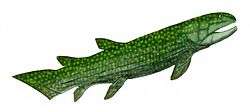Hyneria
| Hyneria Temporal range: 360 Ma (Famennian)[1] | |
|---|---|
| Scientific classification | |
| Kingdom: | Animalia |
| Phylum: | Chordata |
| Subphylum: | Vertebrata |
| Class: | Sarcopterygii |
| Subclass: | Tetrapodomorpha |
| Superorder: | Osteolepiformes |
| Family: | Tristichopteridae |
| Genus: | Hyneria Thomson, 1968 |
| Type species | |
| H. lindae Thomson, 1968 | |
Hyneria is a genus of prehistoric predatory lobe-finned fish that lived during the Devonian period around 360 million years ago.
Etymology
The genus name Hyneria is a reference to the village of Hyner, Pennsylvania, near where the first specimen was found. The species epiphet H. lindae is derived from the name of the wife of Keith Stewart Thomson, who described this fish.[2]
Description
Hyneria was a large fish, estimated at 2.5 m (8.2 ft) in total length,[2] its skull had heavy, ornamented dermal bones and its lower jaw was relatively long and shallow, the teeth were stout with those of the premaxilla forming fangs.[2][3] Its body was covered by cycloid scales.[3]
Discovery
The original fossils came from two localities in Pennsylvania, United States, one found between the villages of Bend and Hyner and another near Emporium. They consisted of a disarticulated partial skull and fragments of the shoulder girdle.[2] The fossils were found in the Catskill Formation of the Red Hill Shale, dating to the upper Devonian.[3] These were the only remains known until 1993 when a renewed collecting effort discovered abundant new material.[3] Hyneria is considered the largest and most common lobe-finned fish found in the Red Hill Shale.[4]
References
- ↑ Haines, Tim; Chambers, Paul (2006). The Complete Guide to Prehistoric Life (illustrated ed.). Canada: Firefly Books. pp. 32–33. ISBN 978-1-55407-181-4.
- 1 2 3 4 Thomson, K. S. (1968). "A new Devonian fish (Crossopterygii: Rhipidistia) considered in relation to the origin of the Amphibia". Postilla. 124.
- 1 2 3 4 Daeschler, EB; Shubin, NH (2007). "New data on Hyneria lindae (Sarcopterygii, Tristichopteridae) from the Late Devonian of Pennsylvania, USA.". Journal of Vertebrate Paleontology. 27 (S3).
- ↑ "The Missing Link". Nova. Season 29http://www.pbs.org/wgbh/nova/transcripts/2905_link.html
|transcripturl=missing title (help). Boston. February 26, 2002. PBS.
External links
- Hyneria at Devonian Times

